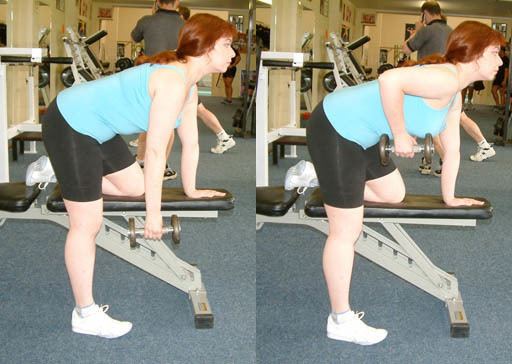A bent-over row (or barbell row) is a weight training exercise that targets a variety of back muscles. Which ones are targeted varies on form. The bent over row is often used for both bodybuilding and powerlifting. It is a good exercise for increasing strength and size.
There are several variants of this exercise, depending on whether dumbbells or a barbell is used:
Two arm barbell bent-over-row: This version uses both arms to lift a barbell from the floor to the stomach in a bent-forward position. The hands are kept pronated and the back straight.Two arm dumbbell bent-over-row: The barbell is replaced by two dumbbells, one for each hand.One arm dumbbell bent-over-row: This exercise is frequently performed with one knee and one hand on the same side of the body braced on a bench with the back straight and parallel to the ground, and the other hand holding a weight with the arm extended. The weight is lifted towards the hip until elbow bends past 90° and the humerus is in line with the back, then lowered to the original position.Kroc row: Named after Janae Marie Kroc who popularised them, Kroc rows are heavy weight and high repetition rows that often call for grip compensating straps at extremely heavy poundages up to around 300 lbs or 140 kg.Chinese dumbbell row: Used as a supplementary exercise by the Chinese weightlifting team, this dumbbell row is of a heavy weight and high repetition scheme that has a 45° stance and little to no rotation at the waist, enabling wider range of motion in upper body and activating the trapezius muscle. The native name for the exercise, if any, is unknown to the English-speaking sports community and it should not be confused with Chinese barbell rows, otherwise known as lying barbell rows.One arm barbell bent-over row: Done in a nearly identical fashion as the one arm dumbbell, but with the added instability of a long bar. This necessitated greater work by the radial and ulnar flexors of the wrist to stabilize while pulling. It also gives greater feedback about the pronation and supination as the movement of the bar is very visible.The muscles emphasized in the pulling movement vary based on form:
The latissimus dorsi muscle is best targeted with the elbow close to the torso, bringing it to the hip. It is assisted by the lower trapezius fibers in adducting the scapulae. The latissimus dorsi originate in fascia of the lower back, so the mass is pulled to a place closer to the pelvis. This reduces the amount of work the lower back has to do.The transverse extensors (posterior deltoid muscle fibers and the infraspinatus and teres minor of the rotator cuff), along with scapular retractors such as the rhomboids and entire trapezius, are better targeted when the elbows are brought outwards. This increases the demands on the lower back as the weight is pulled to a point further away from the pelvis.A medium between the extremes can also be done, such as pulling to a 45-degree angle. Form can easily switch between the two when done with dumbbells. A pronated forearm and a wide grip on a barbell encourages an elbows-out row, while a supinated forearm and a narrow grip on the barbell encourages an elbows-in row.
Chances of being injured are increased when a lifter deviates from safer postures. Adopting a stable form and alignment can be difficult for many to learn. Being supervised by someone experienced in doing the lift can benefit beginners who would not be aware of unsafe postures. Some things that people do with the desire of safety are:
Keeping the abs tense to support the back. This likely means contraction of the transversus abdominis, as contraction of the rectus abdominis would cause the back to round and de-activate the lower back.Allowing bend in the knees: this lowers the center of gravity and the pelvis is brought closer to the ground. It can decrease stretch in the hamstrings, and make it easier to pick a weight off the ground. It also makes it easier to set the weight down as dropping it would be riskier.Maintaining an arch (a slight concavity) in the spine for a healthy lower back.Starting out by lifting lower weights to build endurance in the lower back as well as the upper pulling muscles. Upper back muscles often have a lot of slow-twitch fibers so bent-over rows can respond better than some exercises that use muscles with a higher ratio of fast-twitch fibers.Doing the exercise with a slow tempo and avoiding jerking. This allows stricter attention to be paid to form by observing deviations throughout the lift and keeping the hips and spine more stable. This also prevents momentum from creating momentary weightlessness or slack in the muscles during the ascent, or from creating a jerking catch on the bottom of the lift if it is dropped quickly.
